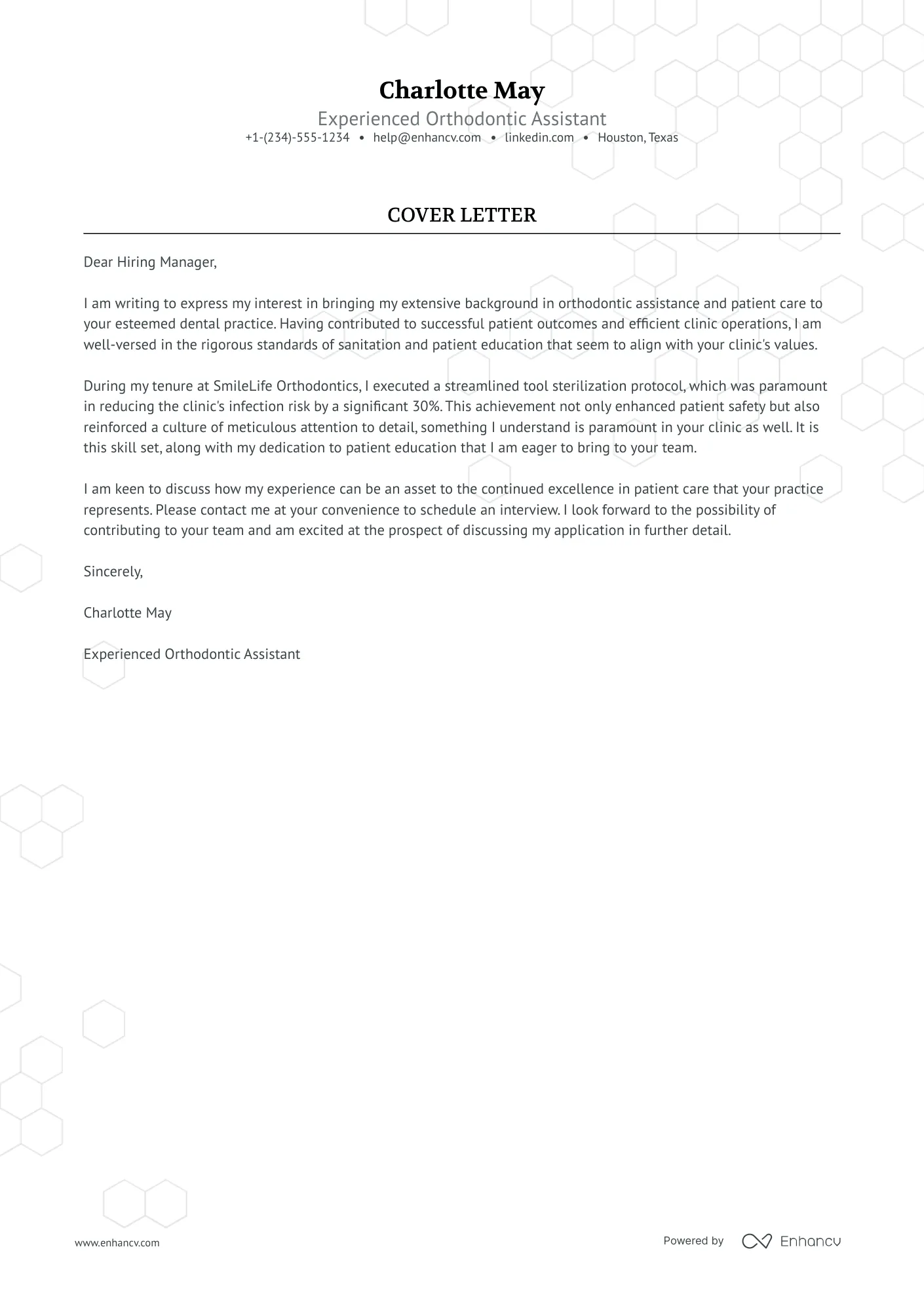Crafting Your Orthodontic Assistant Cover Letter
A well-crafted cover letter is your first opportunity to make a strong impression on a potential employer. For an orthodontic assistant, this document should highlight your relevant skills, experience, and enthusiasm for the role. This comprehensive guide will walk you through the process of creating an effective cover letter that can significantly increase your chances of landing an interview. We’ll cover essential components, provide examples, and offer tips to make your application stand out in 2024’s competitive job market. Your cover letter is more than just a formality; it’s a chance to showcase your personality and demonstrate why you are the best fit for the position. It’s also a great opportunity to show your understanding of the practice and the role, demonstrating your commitment to the field of orthodontics.
Essential Cover Letter Components
Every successful cover letter contains several key elements that work together to present you in the best possible light. These components provide structure and ensure that you include all the necessary information. Each section contributes to a cohesive and persuasive presentation of your qualifications. Ensure that each component is concise, clear, and directly relevant to the role of an orthodontic assistant. This section breaks down these crucial parts, giving you a roadmap to build a cover letter that attracts attention and helps you advance in your job search. The goal is to provide a clear and compelling narrative that compels the hiring manager to consider you seriously for the position.
Contact Information and Date
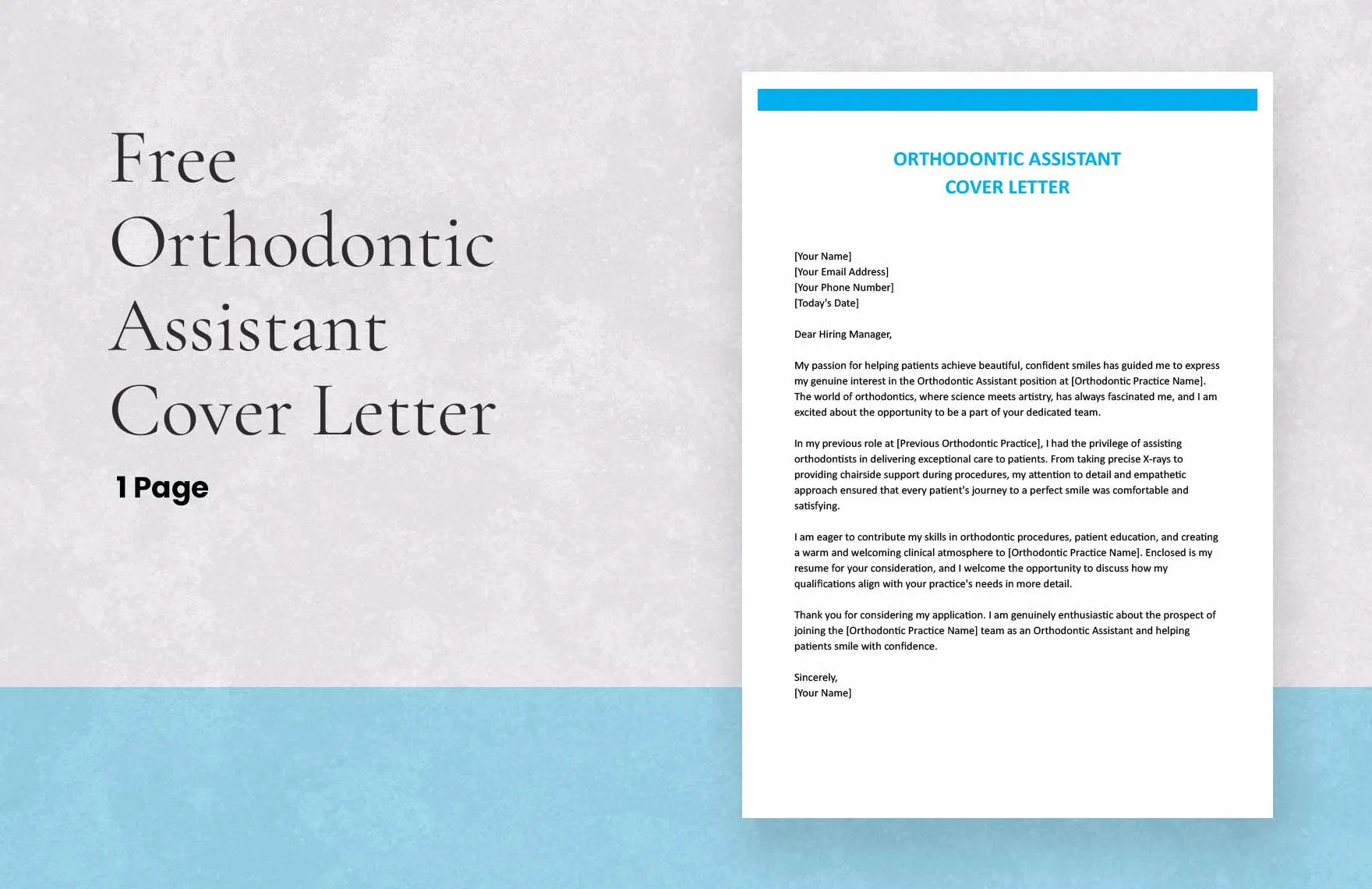
Start with your contact information at the top of the letter. Include your full name, address, phone number, and professional email address. Make sure your email address sounds professional. Directly below your contact information, add the date of the cover letter. Ensure this information is properly formatted and easy to read. This ensures the hiring manager knows how to reach you and the date on which the letter was written. It is a basic but important part of setting a professional tone. Make sure the information is accurate and current to facilitate communication.
The Salutation
Use a professional salutation. If possible, address the hiring manager by name. Researching the practice’s website or LinkedIn can help you find the name of the person responsible for hiring. If you are unable to find a specific name, use a general greeting, such as “Dear Hiring Manager.” Avoid generic greetings like “To Whom It May Concern” as they can make your letter feel impersonal. Addressing the letter to a specific person shows that you have done your homework and are genuinely interested in the position. Proper salutations can make a difference, making you more likely to be considered for the role.
The Opening Paragraph
The opening paragraph is your opportunity to grab the reader’s attention. State the specific position you are applying for and where you found the job posting. Briefly mention why you are interested in the role and the practice. If you have a personal connection to the practice or a particular interest in orthodontics, this is a good place to mention it. Highlight your enthusiasm and make a strong first impression. Your initial sentences should provide context and express your interest immediately. The initial impression can significantly influence the hiring manager’s decision. Set a positive tone and signal your genuine interest in the opportunity.
Highlighting Your Skills and Experience
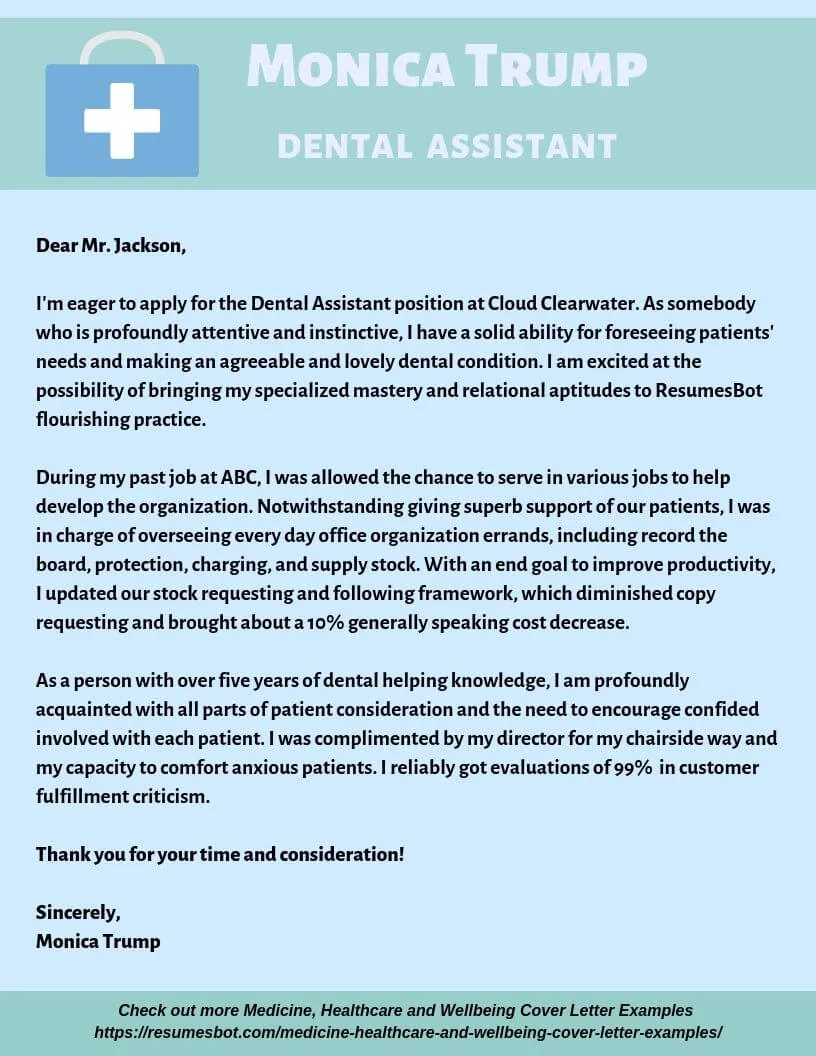
This is the core of your cover letter. Use the body paragraphs to showcase your skills and experience. Explain how your qualifications align with the requirements of the orthodontic assistant position. Provide specific examples of your achievements and responsibilities in previous roles. Quantify your accomplishments whenever possible. For instance, “Assisted in the treatment of 50+ patients per week.” This is a great chance to demonstrate what makes you unique. It is important to showcase skills and experiences that are relevant to the role. The goal here is to show that you are prepared for and capable of fulfilling the responsibilities of the role.
Relevant Skills for Orthodontic Assistants
Orthodontic assistants require a diverse set of skills. Highlight those most relevant to the role. This includes skills in patient care, clinical assisting, and office administration. Consider the specific skills mentioned in the job description and tailor your letter accordingly. You may showcase these skills by providing specific examples from your experience. Your cover letter should reflect a mix of technical and interpersonal skills that demonstrate your overall capabilities. Highlight skills such as taking x-rays, assisting with bracket placement, and sterilizing instruments. Also, it is important to show excellent patient communication skills and strong organizational abilities. The image ‘orthodontic-assistant-skills.webp’ can be helpful here.
Orthodontic Procedures Proficiency
Emphasize your experience with orthodontic procedures. Mention specific procedures you are proficient in, such as taking impressions, placing and removing archwires, and assisting with various orthodontic treatments. Highlight any certifications or training related to orthodontic procedures. Provide examples of how you have successfully performed these procedures in the past. Be as specific as possible to show your practical experience. Demonstrate a strong foundation in these areas. Ensure your letter reflects a thorough understanding of various procedures and how you can contribute to efficient and effective patient care. The image ‘orthodontic-procedures.webp’ can be helpful here.
Patient Care and Communication Skills
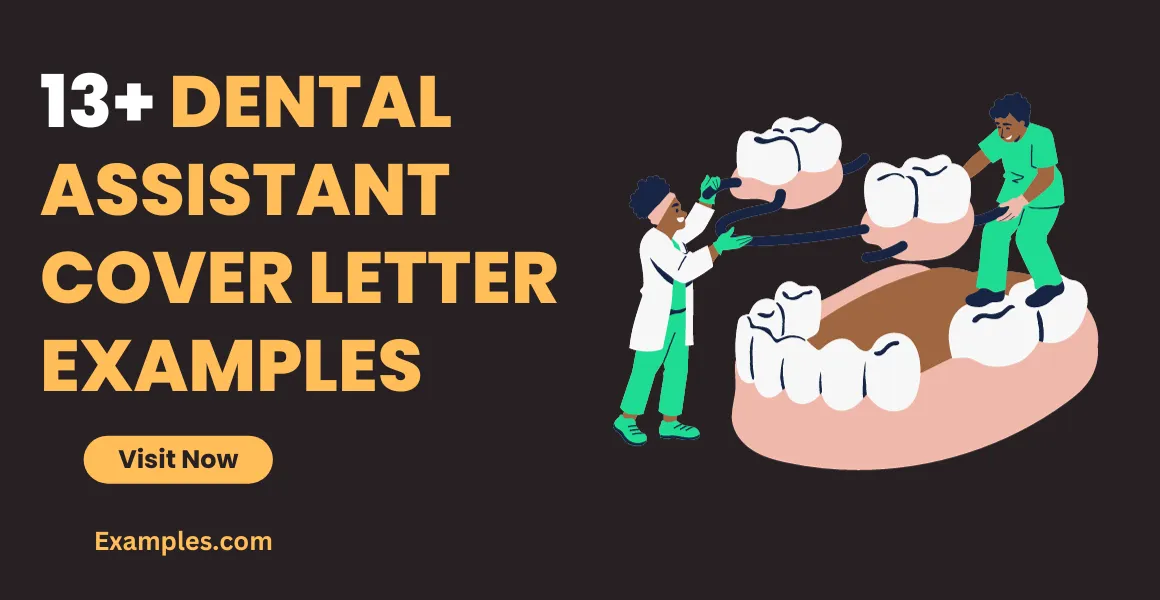
Exceptional patient care and communication skills are crucial for an orthodontic assistant. Describe your ability to build rapport with patients, explain treatment plans, and address their concerns. Provide examples of situations where you demonstrated excellent communication and empathy. Emphasize your ability to create a comfortable and reassuring environment for patients. Highlight any experience you have in managing patient inquiries, handling sensitive information, and providing exceptional customer service. These are all aspects that make you a strong applicant. Demonstrate your commitment to a positive patient experience. The image ‘patient-care-communication.webp’ can be helpful here.
Detailing Your Orthodontic Experience
Provide detailed information about your experience. Include the name of the practices where you have worked, your job titles, and the dates of your employment. Briefly describe your responsibilities in each role. Use strong action verbs to describe your duties and accomplishments. Focus on experiences that are directly relevant to the position of an orthodontic assistant. The more specific you are, the better. This helps demonstrate to the employer the depth of your experience and suitability for the role. Show a track record of success in similar environments. Be sure to give a clear, concise history of your time in the field.
Quantifying Your Achievements
Whenever possible, quantify your achievements. Use numbers to showcase your impact. For example, mention the number of patients you assisted daily or the percentage increase in patient satisfaction scores under your care. Quantifiable achievements make your accomplishments more compelling. Quantifying your contributions gives hiring managers a clearer understanding of your abilities. Numbers provide concrete evidence of your capabilities. Quantifiable data helps demonstrate your value and contributions. The more you quantify, the better the impression you make.
Showcasing Your Passion
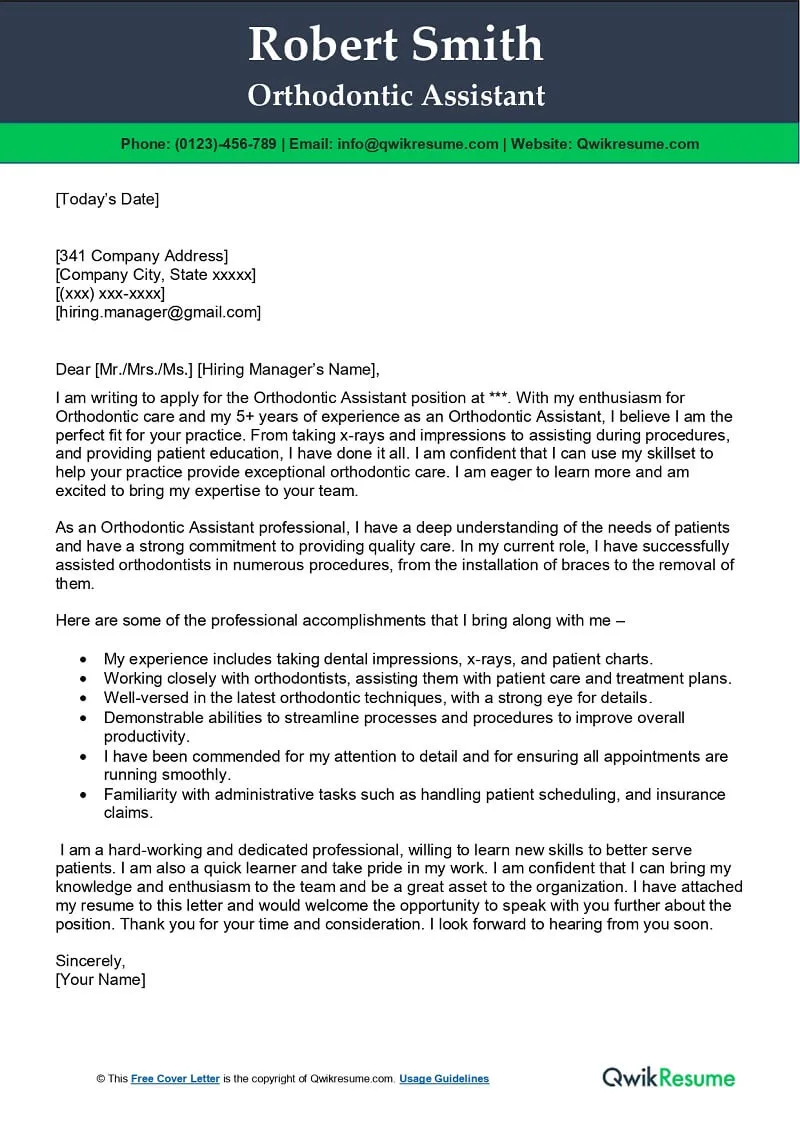
Demonstrate your passion for orthodontics. Show your interest in the field, mentioning any specific aspects you find particularly engaging. This shows enthusiasm and dedication. This could be related to specific treatments or technologies. Mention any professional development activities you’ve been involved in, such as attending conferences or pursuing additional training. It helps set you apart from other candidates. Your enthusiasm can make a big difference. Your genuine interest is a compelling reason for an employer to choose you. Showcase the passion for what you do.
The Closing Paragraph
Conclude your cover letter with a strong closing paragraph. This paragraph provides a final opportunity to reiterate your interest and summarize your key qualifications. It should reaffirm your interest in the position and reiterate your enthusiasm for the opportunity. Provide an action-oriented conclusion. Summarize your interest and re-emphasize your qualifications. Thank the hiring manager for their time and consideration. Express your eagerness to discuss your qualifications further in an interview. Ensure the closing is positive and professional.
Expressing Gratitude and Next Steps
Thank the hiring manager for considering your application. Express your enthusiasm for the opportunity and reiterate your interest in the position. State your availability for an interview and provide your contact information. Include a call to action, such as, “I look forward to hearing from you.” Acknowledge their time and express your interest in the next steps. A professional closing ensures you maintain a positive impression. Offer your availability for an interview and provide contact information for easy follow-up.
Proofreading and Formatting Your Letter
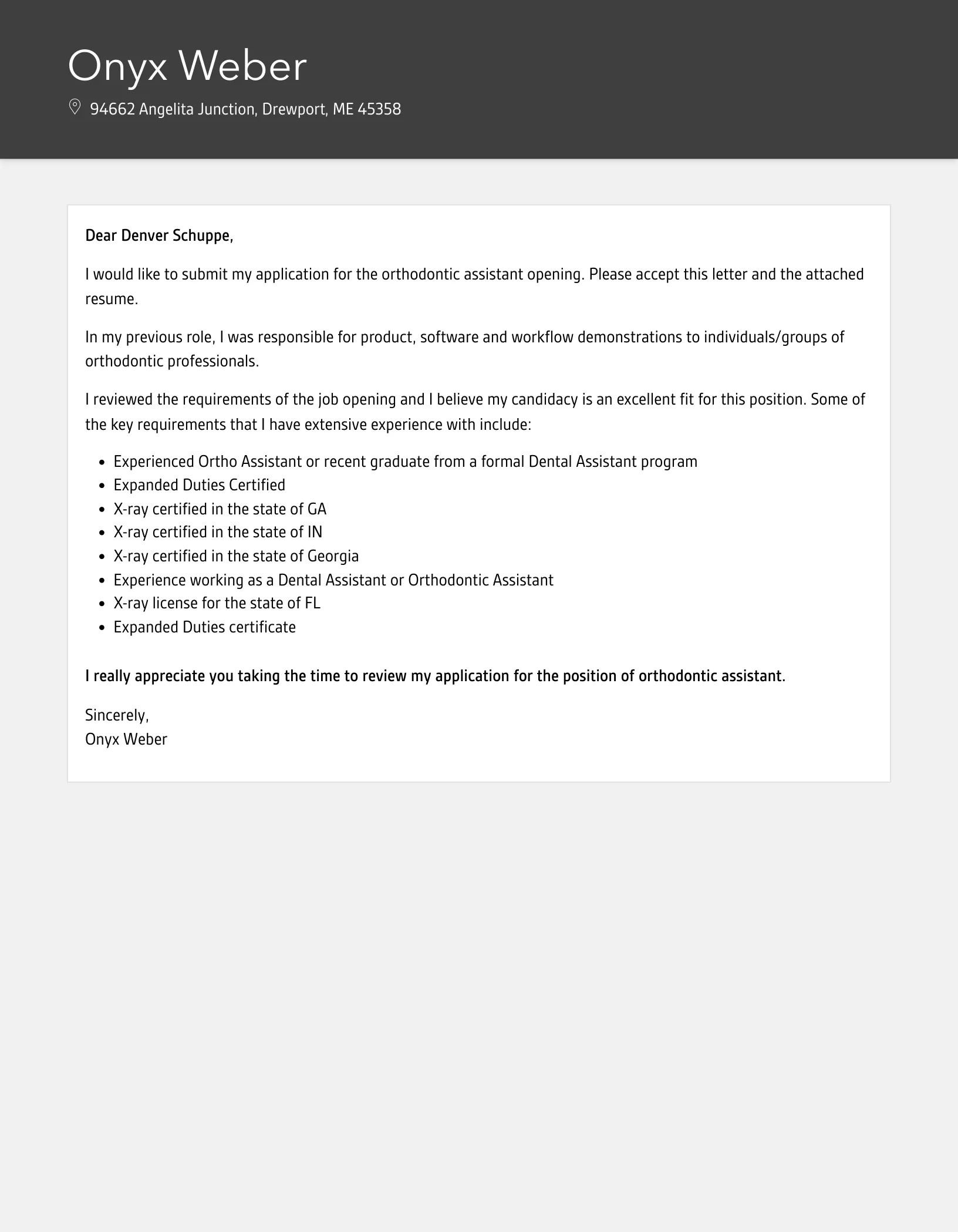
Proofreading and formatting are critical steps. Ensure that your cover letter is free from errors and presents a polished image. Errors can undermine your credibility. Always double-check for grammatical errors, spelling mistakes, and punctuation issues. Use a professional and easy-to-read font, such as Times New Roman, Arial, or Calibri. Pay attention to the overall layout and ensure your letter is well-organized. Proper formatting makes your letter easier to read and presents you in a professional light. Avoid making any formatting mistakes. Presentation matters, so be as professional as possible.
Formatting Guidelines
Follow standard business letter format. Use one-inch margins. Left-align your text, and avoid justified text. Use single spacing within paragraphs and double spacing between paragraphs. Break up large blocks of text into smaller paragraphs to make the letter easier to read. Keep the letter concise and focused, ideally one page in length. Ensure that the letter is well-organized and easy to read. These formatting guidelines enhance the overall appearance of your letter. Proper formatting helps improve readability and showcases professionalism. The image ‘cover-letter-formatting.webp’ can be helpful here.
Common Mistakes to Avoid
Avoid common mistakes that can negatively impact your application. Do not use generic cover letters. Avoid typos, grammatical errors, and spelling mistakes. Do not include irrelevant information. Do not be overly casual or informal in your tone. Avoid using clichés or overused phrases. Do not exceed one page in length. Addressing these issues will help your letter stand out. Avoid these pitfalls to ensure your letter conveys a polished and professional image. Taking the time to avoid these mistakes is very important.
Using Action Verbs
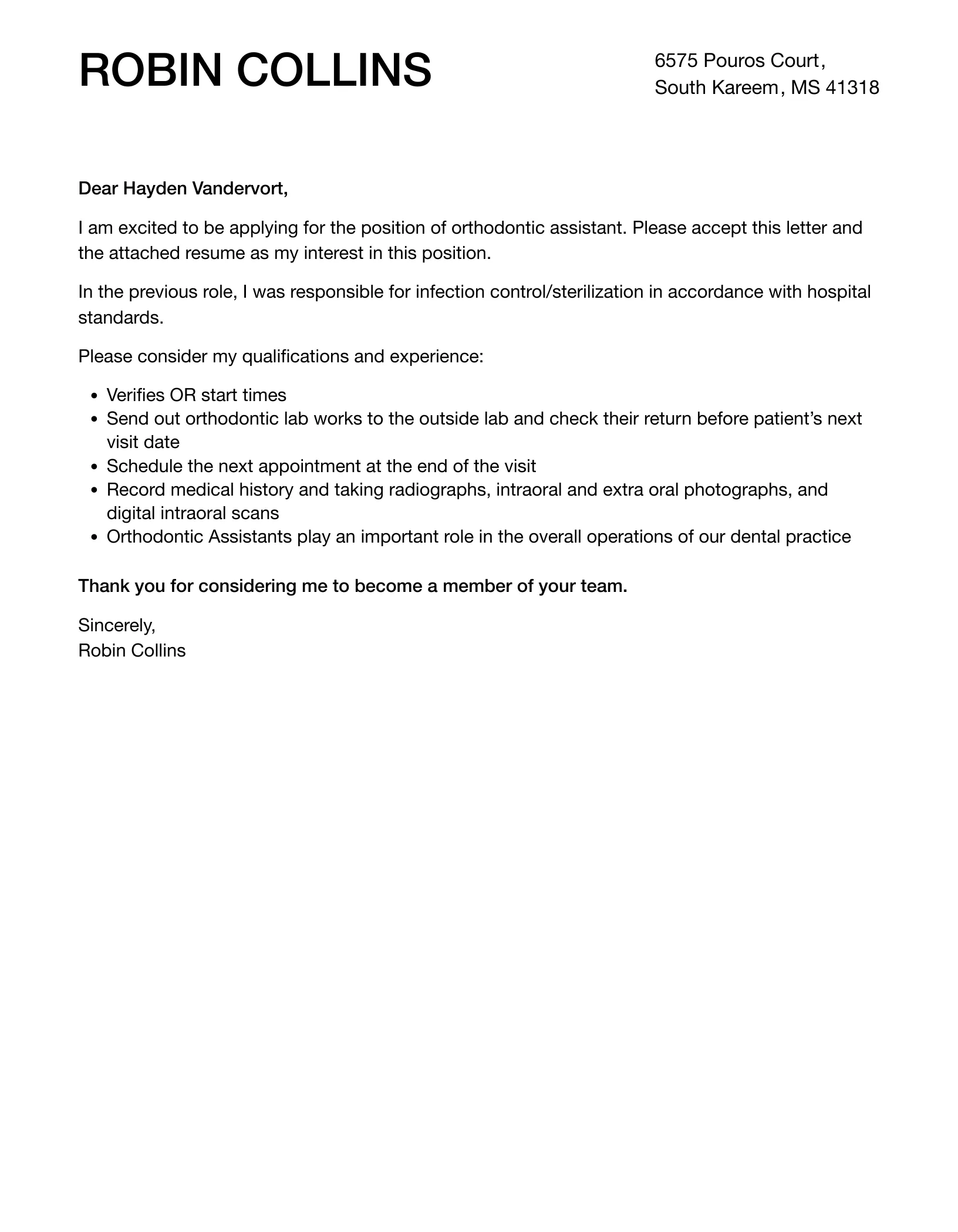
Action verbs make your cover letter more compelling. Use strong action verbs to describe your responsibilities and accomplishments. Examples include “assisted,” “managed,” “implemented,” “coordinated,” “trained,” and “maintained.” Action verbs help to show your initiative and make your achievements more vivid. This makes your qualifications seem more dynamic. Action verbs will make your letter more engaging and show you as a proactive candidate. Using such verbs makes your letter stronger.
Orthodontic Assistant Cover Letter Examples
Reviewing cover letter examples can help you understand the structure and tone. Look at examples tailored to orthodontic assistant positions. Adapt these examples to fit your experience and the specific job requirements. Pay attention to the language used and the way skills and experience are presented. It is a great way to get a head start on the process. They can provide you with a starting point. A well-crafted example will help you learn how to write your letter. The image ‘orthodontic-assistant-example.webp’ can be helpful here.
Example Cover Letter 1
This section will present an example cover letter. The example shows a structured approach and highlights skills such as taking impressions, assisting with bracket placement, and sterilizing instruments. The sample cover letter will give you ideas on how to structure and write your cover letter. The example shows the proper format and highlights key points. This example will help you see how to apply the concepts discussed to your own cover letter.
Example Cover Letter 2
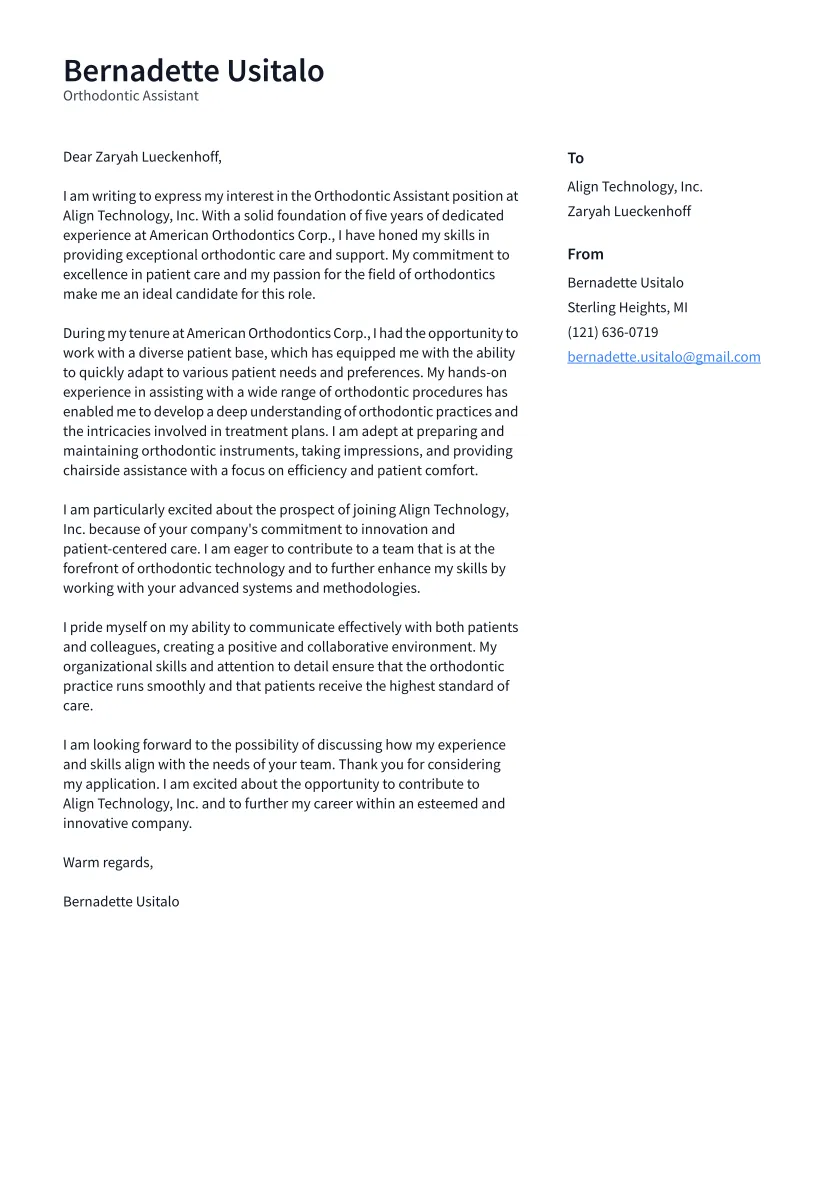
This section will showcase another example cover letter. This example will demonstrate how to showcase excellent communication and patient care skills. The example provides a variety of ways to highlight different skills. Reviewing multiple examples will give you more ideas on structuring your cover letter. This will help you see how to best present your skills and experience. This example offers another approach to drafting a cover letter. This one will help you be more confident in your approach.
Tailoring Your Cover Letter
Tailor your cover letter to each job application. Customization makes your application more relevant and shows that you have carefully considered the specific requirements of the role. Take the time to customize your cover letter. Address the specific requirements of the job and adjust accordingly. This shows that you understand the needs of the practice. The more specific you are, the more likely it is that your application will stand out. It shows you have genuine interest.
Researching the Practice
Research the orthodontic practice before you apply. Visit the practice’s website, check social media, and read patient reviews. Understand the practice’s values, mission, and any specializations they have. This helps you tailor your cover letter to align with their specific needs. This also demonstrates your genuine interest in the practice. Show your familiarity with the practice. Show that you’re not just sending out generic applications. The image ‘research-practice.webp’ can be helpful here.
Customizing for the Specific Role
Carefully review the job description. Identify the key skills and qualifications the employer is seeking. Highlight your relevant skills and experience. Use keywords from the job description in your cover letter. Provide examples that directly address the requirements of the role. Tailor each application to match the specific needs of the practice and the specific role. This will show you’re a good fit. Make sure you’re aligning your qualifications with the requirements of the specific role.
Submitting Your Cover Letter
Pay attention to how you submit your cover letter. Following the application instructions carefully increases your chances of success. Make sure to use the correct file format and submission method. Accuracy in submission is vital to being considered. A little attention to detail can take you far in the process. You can show professionalism by doing so.
File Format and Submission Methods
Unless specified otherwise, submit your cover letter in PDF format. This ensures that your formatting remains consistent across different devices and operating systems. Follow the instructions provided in the job posting regarding the submission method. Send your cover letter and resume together as a single attachment. Always double-check the file name and ensure the file is correctly formatted. If the job posting requests the cover letter to be included in the body of the email, follow those instructions. Check if there are additional requirements or guidelines. The image ‘submit-cover-letter.webp’ can be helpful here.
